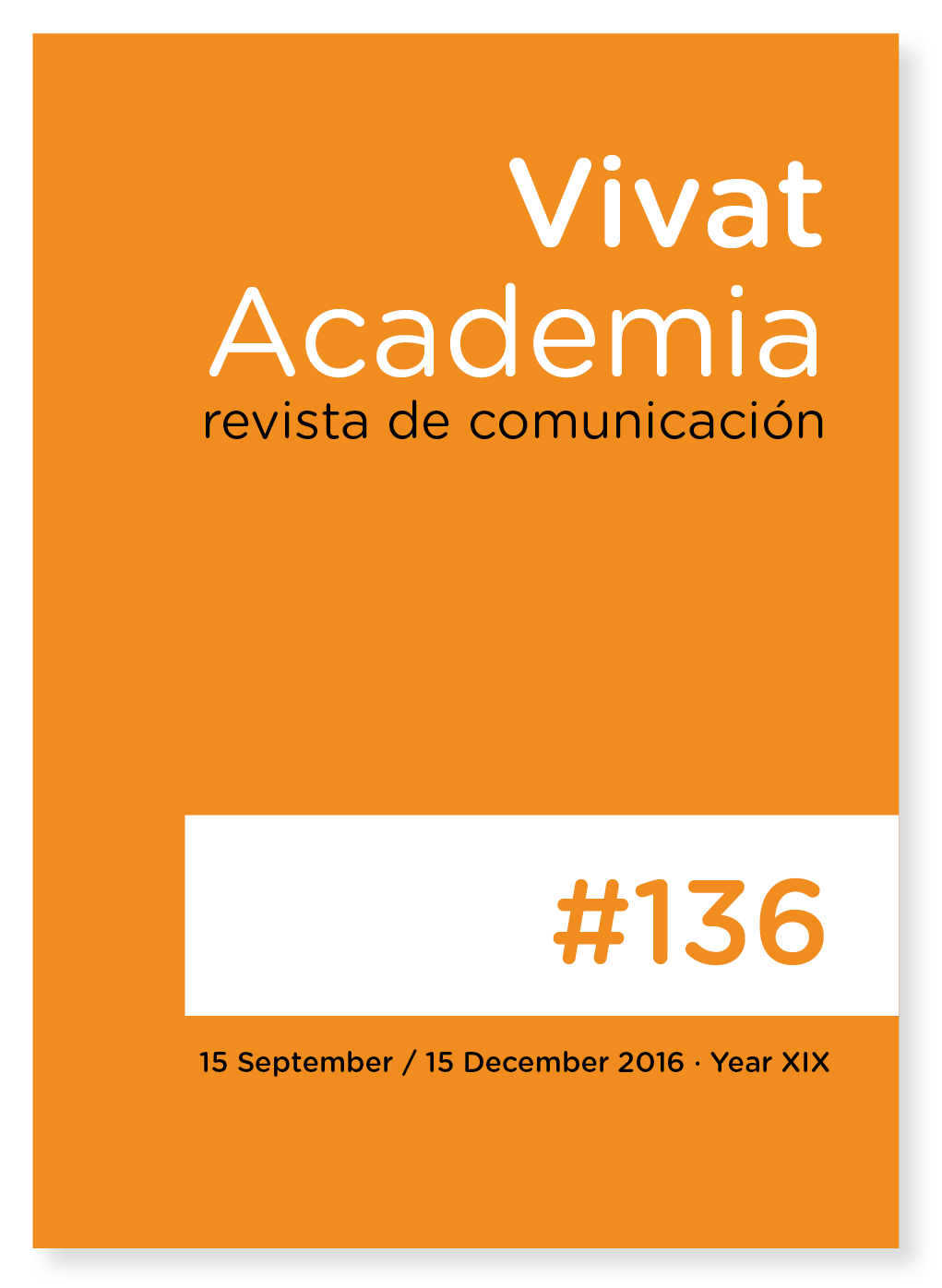Music and movement in Pixar: the TSU’S as an analytical resource
Main Article Content
Abstract
The music for the animation cinema is closely linked with the characters’ movement and the narrative action. This paper presents the Temporary Semiotic Units (TSU’s) proposed by Delalande, as a multimodal tool for the music analysis of the actions in cartoons, following the tradition of the Mickey Mousing. For this, a profile with the applicability of the nineteen TSU’s was applied to the fourteen Pixar movies produced between 1995-2013. The results allow us to state the convenience of the use of the TSU’s for the music comprehension in these films, especially in regard to the subject matter and the characterization of the characters and as a support to the visual narrative of this genre.
Downloads
Article Details
The main author must deliver the letter of transfer of copyright, according to the model provided by Vivat Academia, Revista de comunicación, which declares the transfer of copyright to the journal and make explicit the rights of authors regarding the dissemination and use of the manuscript once published.
Creative Commons Attribution/Non Commercial 4.0 International
References
Libros completos:
Alcazar, A. J.; Gustems, J. & Calderón, D. (2014). Los modos de escucha como generadores de pensamiento musical: a propósito de François Delalande, en Observar, n º 8. Págs.86-108.
Aróstegui, J. L. (2009). La música en los dibujos animados, en Olarte, M. (Ed.). Reflexiones en torno a la música y la imagen desde la Musicología española (553-563). Salamanca: Plaza Universitaria.
Bruner, J. (1986). Actual Minds, Possible Worlds. Cambridge: Harvard University Press.
Callejas, Z.; López-Cózar, R. & Gea, F. M. (2005). Análisis de Metodologías de evaluación de Sistemas de Diálogo Multimodal, en Procesamiento del lenguaje natural, nº 34. Págs. 9-16.
Chion, M. (1993). La audiovisión. Introducción a un análisis conjunto de imagen y sonido. Barcelona: Paidós.
Cohen, A. J. (2013). Film Music and the Unfolding Narrative, en Strüngmann, M. A. (Ed.). Language, Music, and the Brain (173-200). Cambridge: MIT Press, 173-200.
Delalande, F. (1996). Les Unités Sémiotiques Temporelles: problématique et essai de défnition, en MIM. Les Unités Sémiotiques Temporelles (16-25). Marsella: MIM.
Duerden, R. (2007). Dancing in the Imagined Space of Music, en Dance Research, nº25, vol. 1. Págs. 73-83.
Duran, J. (2009). Narrativa audiovisual i cinema d’animació per ordenador. (Tesis doctoral). Universitat de Barcelona, Barcelona.
Gustems, J. & Calderón, C. (2014). El análisis multimodal en la escucha de los audiovisuales, en Gustems, J. (Ed.). Música y Audición en los Géneros Audiovisuales (15-28). Barcelona: Publicacions i Edicions de la Universitat de Barcelona.
Kress, G. & Van Leeuwen, T. (2001). Multimodal discourse. The modes and media of contemporary Communication. Londres: Edward Arnold.
Lemke, J. (1998). Multiplying Meaning: Visual and Verbal Semiotics in Scientific Text, en Martin, M. A. & Veel, R. (Eds.). Reading Science (87-113). Londres: Routledge.
Llinares, F. (2012). El sonido como recurso expresivo en los audiovisuales, en Gustems, J. (ed.). Música y Sonido en los audiovisuales (135-145). Barcelona: Universitat de Barcelona.
Marimon, J. (2014). El montaje cinematográfico. Del guión a la pantalla. Barcelona: Publicacions i Edicions de la Universitat de Barcelona.
MIM (1996). Les Unités Sémiotiques Temporelles. Marsella: MIM .
MIM (2002). Les Unités Sémiotiques Temporelles: nouvelles clés pour l’écoute. Ouil d’analyse musicale. Marsella: MIM.
Neumeyer, D. & Buhler, J. (2001). Analytical and Interpretive Approaches to Film Music (I): Analysing the Music, en Donnelly, K. J. (Ed.). Film Music: Critical Approaches (16-38). Nueva York: The Continuum International Publishing Group.
Radigales, J. (2001). Creació i muntatge musical en el dibuix animat clàssic, en Trípodos, nº11. Págs. 107-122.
Smith, M. (2000). Ballet and Opera in the age of Giselle. Princeton: Princeton University Press.
Torelló, J. & Duran, J. (2014). Michel Chion en La audiovisión y una propuesta práctica sobre un fragmento de Nostalgia de Andrei Tarkovski, en L’Atalante, nº18. Págs. 111-117.
Valvassori, M. (2006). El personaje trickster o "burlador" en el cuento tradicional y en el cine de dibujos animados, en Culturas Populares, Revista electrónica, nº1. Págs. 1-27.
Whalen, Z. (2004). Play along. An Approach to Videogame Music, en Game Studies, nº 4, vol. 1. Págs. 1-31.
Publicaciones periódicas:
Artículos en papel y electrónicos:
Farrar, E. (2003). A Method for Mapping Expressive Qualities of Music to Expressive Qualities of Animation. Recuperado de http://accad.osu.edu/~efarrar/thesis/proposal120602.pdf. Consultado el 13/11/2015.
Hautbois, X. (2010). Les Unités Sémiotiques Temporelles: de la semiotique musicale vers una sémiotique générale du temps dans les arts, en Les UST: enjeux pour l’analyse et la recherche. Musimédiane. Revue audiovisuelle et multimédia d’analyse musical. Recuperado de http://www.musimediane.com/ Consultado el 14/10/2015
Jones, C. (1946). Music and the Animated Cartoon, en Hollywood Quarterly, nº1, vol. 4. Págs. 364-370.
Royce, T. (1998). Synergie on the page: exploring intersemiotic complementarity in page-based multimodal text, en Japan Association Systemic Functional Linguistic Occasional Papers, nº1, vol. 1. Págs 25-50.
Rosenberg, N. (1983). Image and Stereotype: Bluegrass Sound Tracks, en American Music, nº1, vol. 3. Págs. 1-22.





